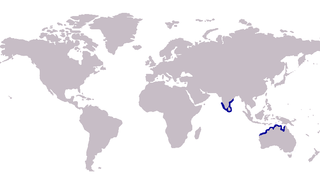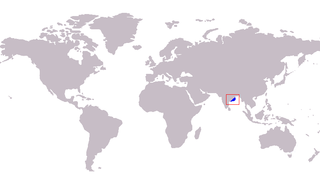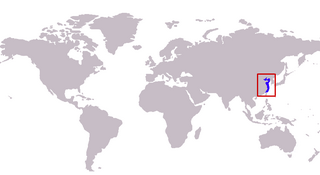
Smelts are a family of small fish, the Osmeridae, found in the North Atlantic and North Pacific oceans, as well as rivers, streams and lakes in Europe, North America and Northeast Asia. They are also known as freshwater smelts or typical smelts to distinguish them from the related Argentinidae, Bathylagidae, and Retropinnidae.

The Osmeriformes are an order of ray-finned fish that includes the true or freshwater smelts and allies, such as the galaxiids and noodlefishes; they are also collectively called osmeriforms. They belong to the teleost superorder Protacanthopterygii, which also includes pike and salmon, among others. The order's name means "smelt-shaped", from Osmerus + the standard fish order suffix "-formes". It ultimately derives from Ancient Greek osmé + Latin forma, the former in reference to the characteristic aroma of the flesh of Osmerus.

The New Zealand smelt, also known as the New Zealand common smelt, New Zealand cucumber fish, or silveries is a smelt of the family Retropinnidae, found only in New Zealand at shallow depths in estuaries and rivers. Their length is between 8 and 13 cm.

The Asian whiting is a species inshore marine fish in the smelt whiting family, Sillaginidae, distributed along the Asian coastline from the Gulf of Thailand to Taiwan. The Asian whiting's appearance is very similar to other closely related species in the genus Sillago, with swim bladder morphology and ray counts of fins the most reliable identifying features. The species inhabits slightly deeper water than many of the sillaginid species its distribution overlaps, forming an important part of the whiting fishery in the countries within its range.

The slender whiting is a poorly known species of inshore marine fish of the smelt whiting family, Sillaginidae that has a distribution limited to the Persian Gulf only. The Slender whiting, like most sillaginids requires careful study to determine its identity, with ray and vertebrae counts as well as swim bladder morphology distinguishing features. This inshore species of fish is commonly taken by fishermen using beach seines and is sold fresh in local markets.

The big-scale sand smelt is a species of fish in the family Atherinidae. It is a euryhaline amphidromous fish, up to 20 cm in length.

Sillago indica, the Indian sillago, is a poorly known species of coastal marine fish of the smelt-whiting family Sillaginidae. The species was named in 1985, having previously being misidentified as another species of Sillago, S. parvisquamis. The Indian sillago inhabits the coasts of the Indian subcontinent and Oman. Like all sillaginids, it is benthic in nature, living in depths to 30 m where it is caught by fishermen alongside other species of Sillago.

The Intermediate whiting, is a species of coastal marine fish of the smelt-whiting family Sillaginidae. The intermediate whiting ranges from the west coast of India to the Gulf of Thailand in the east, inhabiting silty substrates in shallow waters. First identified in 1977 from a specimen found in a fish market, the species has had little research performed on its biology, and is frequently misidentified as Sillago sihama or Sillago maculata intermediate whiting are commonly caught by fishermen throughout their range and are marketed fresh locally.

The mud whiting, or mud sillago, is a species of coastal marine fish in the smelt-whiting family Sillaginidae. The mud whiting was first described in 1985 and is currently known from the north west coast of Australia and the Indian coast.

The large-scale whiting the only member of the genus Sillaginops, is a poorly understood species of coastal marine fish of the smelt- whiting family Sillaginidae. First described in 1859, the large-scale whiting is known to inhabit shallow waters along the coasts of a number of Indo-Pacific countries including Japan, Indonesia, Philippines and the Solomon Islands. Little is known of the species biology, even though it is of minor importance to fisheries throughout its range.

The small-eyed whiting is a poorly known species of coastal marine fish of the smelt-whiting family Sillaginidae. The species is known from only two specimens; the holotype collected by Roland McKay in 1985 from a Taipei market, both specimens of which were taken from the waters of Taiwan. Apart from a relatively small eye size, the species is hard to distinguish from other common species of sillaginid taken in the area, and may be a minor part of local fisheries.

The northern whiting, also known as the silver whiting and sand smelt, is a marine fish, the most widespread and abundant member of the smelt-whiting family Sillaginidae. The northern whiting was the first species of sillaginid scientifically described and is therefore the type species of both the family Sillaginidae and the genus Sillago. The species is distributed in the Indo-Pacific region from South Africa in the west to Japan and Indonesia in the east. The northern whiting inhabits coastal areas to 60 m, but is most often found in shallow water around bays and estuaries, often entering freshwater. It is a carnivore, taking a variety of polychaetes and crustaceans. The species is of major economic importance throughout the Indo-Pacific. It is most frequently taken by seine nets and cast nets and marketed fresh.

The soringa whiting, also known simply as soringa or soringa sillago, is a poorly known species of coastal marine fish of the smelt-whiting family, Sillaginidae. The Soringa whiting is known exclusively from the east coast of India, inhabiting shallow inshore environments, particularly sandy substrates. S. soringa was first described in 1982 by Dutt and Sujatha, with the taxonomic status of the species was questioned by Roland McKay in his review of the Sillaginidae, with similar features to S. asiatica suggesting it is a senior synonym of the latter.

The Argentiniformes is an order of marine ray-finned fish whose distinctness was recognized only fairly recently. In former times, they were included in the Osmeriformes as suborder Argentinoidei. That term refers only to the suborder of marine smelts and barreleyes in the classification used here, with the slickheads and allies being the Alepocephaloidei. These suborders were treated as superfamilies Argentinoidea and Alepocephaloidea, respectively, when the present group was still included in the Osmeriformes.
Microstoma is a genus of pencil smelt.

The Mediterranean sand smelt, Atherina hepsetus, is a species of fish in the family Atherinidae that inhabits the littoral zone of the east Atlantic, the Mediterranean and the Black Sea.

The Chinese sillago is a species of inshore marine fish in the smelt whiting family Sillaginidae, described in 2011. The species is known only to inhabit the coastal waters of China, primarily in estuarine tidal flats near Wenzhou, Zhejiang Province. The Chinese sillago was described in 2011 based on morphological and DNA barcode analysis of several specimens. Several detailed anatomic features distinguish it from other sillaginids, with Sillago parvisquamis its closest relative based on phylogenetic analysis. Nothing is known of the ecology or importance to fisheries of the Chinese sillago.

Nansenia is a genus of pencil smelts.
The snubnose blacksmelt is a species of ray-finned fish in the deep-sea smelt family Bathylagidae. It is native to the northeastern Pacific Ocean.
Nansenia oblita, also called the forgotten argentine or the Mediterranean large-eyed argentine, is a species of fish in the pencil smelt family (Microstomatidae).

















